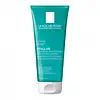Some By Mi Charcoal BHA Pore Clay Bubble Mask Versus La Roche-Posay Effaclar Micro-Peeling Purifying Gel
What's inside
What's inside
 Key Ingredients
Key Ingredients

 Benefits
Benefits

 Concerns
Concerns

 Ingredients Side-by-side
Ingredients Side-by-side

Water
Skin ConditioningButylene Glycol
HumectantSodium Cocoyl Isethionate
CleansingGlycerin
HumectantKaolin
AbrasiveCharcoal Powder
AbrasiveDisodium Laureth Sulfosuccinate
CleansingMethyl Perfluorobutyl Ether
SolventSodium Methyl Cocoyl Taurate
CleansingLauric Acid
CleansingPotassium Cocoyl Glycinate
Coco-Betaine
CleansingAcrylates Copolymer
Manicouagan Clay
AbsorbentMelaleuca Alternifolia Leaf Water
AntimicrobialCentella Asiatica Extract
CleansingCentella Asiatica Leaf Extract
Skin ConditioningArtemisia Princeps Leaf Extract
Skin ConditioningPyrus Malus Fruit Extract
Skin ConditioningMadecassic Acid
Skin ConditioningMadecassoside
AntioxidantAsiaticoside
AntioxidantAsiatic Acid
Skin ConditioningAscorbyl Glucoside
AntioxidantGlutathione
Salicylic Acid
MaskingCaprylyl Glycol
EmollientCitric Acid
BufferingBenzyl Glycol
SolventEthylhexylglycerin
Skin ConditioningRaspberry Ketone
MaskingDisodium EDTA
Parfum
MaskingWater, Butylene Glycol, Sodium Cocoyl Isethionate, Glycerin, Kaolin, Charcoal Powder, Disodium Laureth Sulfosuccinate, Methyl Perfluorobutyl Ether, Sodium Methyl Cocoyl Taurate, Lauric Acid, Potassium Cocoyl Glycinate, Coco-Betaine, Acrylates Copolymer, Manicouagan Clay, Melaleuca Alternifolia Leaf Water, Centella Asiatica Extract, Centella Asiatica Leaf Extract, Artemisia Princeps Leaf Extract, Pyrus Malus Fruit Extract, Madecassic Acid, Madecassoside, Asiaticoside, Asiatic Acid, Ascorbyl Glucoside, Glutathione, Salicylic Acid, Caprylyl Glycol, Citric Acid, Benzyl Glycol, Ethylhexylglycerin, Raspberry Ketone, Disodium EDTA, Parfum
Water
Skin ConditioningSodium Laureth Sulfate
CleansingDecyl Glucoside
CleansingGlycerin
HumectantSodium Chloride
MaskingCoco-Betaine
CleansingSalicylic Acid
MaskingPEG-150 Pentaerythrityl Tetrastearate
EmulsifyingPEG-6 Caprylic/Capric Glycerides
EmulsifyingZinc Gluconate
Skin ConditioningSodium Hydroxide
BufferingCapryloyl Salicylic Acid
ExfoliatingTetrasodium EDTA
Citric Acid
BufferingMenthol
MaskingPolyquaternium-47
Skin ConditioningHexylene Glycol
EmulsifyingSodium Benzoate
MaskingWater, Sodium Laureth Sulfate, Decyl Glucoside, Glycerin, Sodium Chloride, Coco-Betaine, Salicylic Acid, PEG-150 Pentaerythrityl Tetrastearate, PEG-6 Caprylic/Capric Glycerides, Zinc Gluconate, Sodium Hydroxide, Capryloyl Salicylic Acid, Tetrasodium EDTA, Citric Acid, Menthol, Polyquaternium-47, Hexylene Glycol, Sodium Benzoate
 Reviews
Reviews

Ingredients Explained
These ingredients are found in both products.
Ingredients higher up in an ingredient list are typically present in a larger amount.
Citric Acid is an alpha hydroxy acid (AHA) naturally found in citrus fruits like oranges, lemons, and limes.
Like other AHAs, citric acid can exfoliate skin by breaking down the bonds that hold dead skin cells together. This helps reveal smoother and brighter skin underneath.
However, this exfoliating effect only happens at high concentrations (20%) which can be hard to find in cosmetic products.
Due to this, citric acid is usually included in small amounts as a pH adjuster. This helps keep products slightly more acidic and compatible with skin's natural pH.
In skincare formulas, citric acid can:
While it can provide some skin benefits, research shows lactic acid and glycolic acid are generally more effective and less irritating exfoliants.
Most citric acid used in skincare today is made by fermenting sugars (usually from molasses). This synthetic version is identical to the natural citrus form but easier to stabilize and use in formulations.
Read more about some other popular AHA's here:
Learn more about Citric AcidCoco-Betaine is the natural version of Cocamidopropyl Betaine. It is often derived from coconuts.
Coco-Betaine is a surfactant, meaning it helps remove dirt and oil from the skin.
Glycerin is already naturally found in your skin. It helps moisturize and protect your skin.
A study from 2016 found glycerin to be more effective as a humectant than AHAs and hyaluronic acid.
As a humectant, it helps the skin stay hydrated by pulling moisture to your skin. The low molecular weight of glycerin allows it to pull moisture into the deeper layers of your skin.
Hydrated skin improves your skin barrier; Your skin barrier helps protect against irritants and bacteria.
Glycerin has also been found to have antimicrobial and antiviral properties. Due to these properties, glycerin is often used in wound and burn treatments.
In cosmetics, glycerin is usually derived from plants such as soybean or palm. However, it can also be sourced from animals, such as tallow or animal fat.
This ingredient is organic, colorless, odorless, and non-toxic.
Glycerin is the name for this ingredient in American English. British English uses Glycerol/Glycerine.
Learn more about GlycerinSalicylic Acid (also known as beta hydroxy acid or BHA) is a well-known ingredient for treating skin that struggles with acne and clogged pores. It exfoliates both the skin's surface and deep within the pores to help clear out buildup, control oil, and reduce inflammation.
Unlike AHAs (alpha hydroxy acids), salicylic acid is oil-soluble. This allows it to penetrate into pores which makes it especially effective for treating blackheads and preventing future breakouts.
Salicylic acid is also known for its soothing properties. It has a similar structure to aspirin and can calm inflamed or irritated skin, making it a good option for acne-prone skin that is also sensitive.
Concentrations of 0.5-2% are recognized by the U.S. FDA as an over-the-counter topical acne product.
It can cause irritation and/or dryness if one's skin already has a compromised moisture barrier, so it's best to focus on repairing that before introducing this ingredient into your routine.
While salicylic acid does not increase sun sensitivity, it’s still important to wear sunscreen daily to protect your skin.
If you are looking for the ingredient called BHA or Butylated Hydroxyanisole, click here.
Learn more about Salicylic AcidWater. It's the most common cosmetic ingredient of all. You'll usually see it at the top of ingredient lists, meaning that it makes up the largest part of the product.
So why is it so popular? Water most often acts as a solvent - this means that it helps dissolve other ingredients into the formulation.
You'll also recognize water as that liquid we all need to stay alive. If you see this, drink a glass of water. Stay hydrated!
Learn more about Water